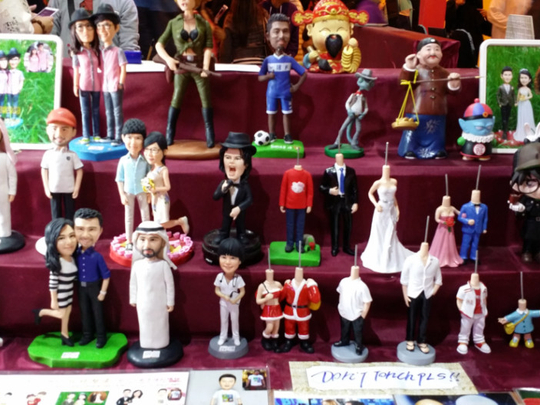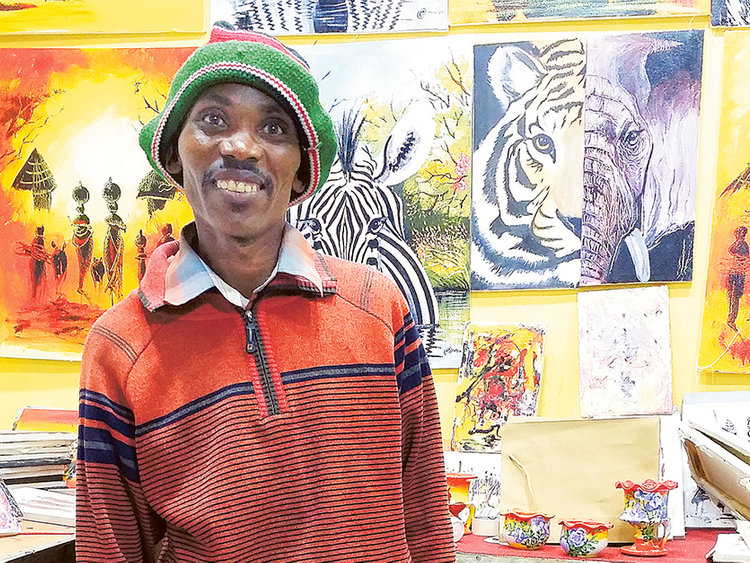
If you have a penchant for traditional fare and authentic cultural influences — Dubai’s Global Village is a must visit. Colonial Baroque from Spain to hand-woven silk rugs from Turkey, Global Village an international arts festival, with more than 70 participating countries.
If you love art and want to get some bargains in just a couple of hours, swing by at least Turkey, India, China, Africa, Iran and Spain. You can walk out of a country and into another without any visa! And don’t be surprised if you come home with amazing artefacts.
Just a stroll through the lanes of the Global Village is an education in art.
Folk artworks, styles and motifs have inspired various artists who have come all the way from far eastern countries or from the African Peninsula. Even better, the crowd at the Global Village in Dubai is not all tourists; there are local artists too.
“Pablo Picasso was inspired by African tribal sculptures and masks, while Natalia Goncharova, Elito Circa and others were inspired by traditional Russian popular prints called luboks. I come here each year to get my dose of world art from its various tribes,” says UAE-based Indian abstract artist Ashvin.
Irungu sells coffee and snacks at the African Pavilion, but he is actually an artist from New Mombasa. He says art is his main source of living. “You can see everything hand-made here. They are made and painted by my people, especially artists who are not able to work full-time. These are created to help supplement any income that do come in. These are a very different, primitive type of art,” explains Irungu, who is a regular contemporary folk artist at the Global Village.
In Tunisa court, you realise it is not always hand-crafted articles that need to talk of a deep cultural influence. At the entrance of the pavilion is a perfume shop that sells only jasmine scent. Imported by the Andalusians in the 16th century, jasmine has become the national flower of Tunisia. The vendor, Sabia, could thus explain why there are large jasmine farms in the country.
In Kuwait, as in many Islamic countries, the art of calligraphy is one of the most striking. Not just classical religious inscriptions but also custom-made calligraphic art is available here for a price that is much lesser than what art galleries offer.
At Global Village, art is primarily utilitarian and decorative rather than purely aesthetic. Here the traditional rules of proportion and perspective are not employed. “I am very impressed by this huge festival of arts and culture, I have made many artist friends in other pavilions too,” says Ma, an marble engraving artist from Shanghai, China. Ma is a professional artist who takes up huge projects back home and is here with his manager, who is networking to find a place for him in the Middle East.
Wax sculptor Wellang Pang, who has travelled all the way from Shilin in the Yunan province of China, says he studied sculpting on stone first as his region is famous for its soft limestones, but he loves to make instant wax figures — and they are a hot favourite among the visitors at the Global Village.
Malaysian batik is a good bargain here at the Global Village. It is a textile art especially prevalent on the east coast of the country. The process of Malaysian batik production is quite different from that of Indonesian Javanese batik as the patterns are larger and simpler and the colours tend to be lighter and more vibrant than the deep hues of Javanese batik. “The most popular motifs are leaves and flowers. Malaysian batik depicting humans or animals are rare because Islamic norms forbid animal images as decoration. However, the butterfly theme is a common exception,” Usman Khaled, who sells batik at the Malaysian pavilion.
Blue Turkish tiles are a steal at the Turkey pavilion. Turkish art technically refers to all works of visual art originating from the geographical area of what is present day Turkey. Turkey was the melting pot of many cultures before Turks came and made it theirs. The country is home to significant art produced by earlier cultures, including the Hittites, Ancient Greeks, and Byzantines. The 16th and 17th centuries were the finest period for art in the Ottoman Empire, with technical influences from Europe adding a sophisticated style.
Iranian art, which boasts of having one of the richest heritages in world history, encompasses many disciplines including architecture, painting, weaving, pottery, calligraphy, metalworking and stonemasonry. There is also a very vibrant Iranian modern and contemporary art scene here at the Global Village. In a small tent nestled between silversmiths who sell semi-precious stones clasped in beautiful silver jewellery, is Ubaik’s carpets. He is a silk carpet weaver whose father and grandfather passed on the family’s trade on to him.
English is not his best language but he said, “Global Village mashallah. Thanks to Shaikh Mohammad,” in all gratitude that explains it has been a good stint for him.
Talk of global influences. In one of the carpets, he has a Ganesha, the elephant deity of Hindus. He sure knows how to transform art to suit the buyer’s sensibilities. But will that remain traditional art in its true flavour? That is debatable.
Each country’s pavilion showcases its traditional art. Small and big traditional mosaic works with wood chips and broken marble pieces adorn the stores at the Iran Pavilion while Spain’s crochet artisans line up an entire street of the country’s pavilion. Some of its contemporary artists have their studios set up here.
Home to avant-garde artists such as Pablo Picasso and Salvador Dali who concentrated on political, social and cultural issues in sculpture, painting and even filmmaking, its artistic potential is not to be ignored. The Spanish baroque and chiaroscuro technique gave artist Juan’s subjects a poignant intensity. He makes minute portraits for customers who line up at his stall. His studio at the Global village has Spanish landscapes as well as three-dimensional portraits. “My inspiration is the Spanish neoclassical artist Francisco Goya who had a panache for often ominous compositions with dark imagery,” says the artist.
Food, music, and literature are deep-rooted among the Lebanese. While traditional dancers welcome you into a festive fervour, what lies beneath is just as spectacular. Contemporary mosaic artist and entrepreneur Hisham, has colourful tiles on display here. He was among the many artists who did not like to be photographed. “If you take pictures my neighbour’s son who learns everything online will make a poor copy. There is much more to what meets the eyes,” says the artist who uses traditional methods to create unique contemporary patterns.
Hisham feels Global Village is a good place to sell real art because the medley of people who come here are diverse and art is always bought on the “first love” phenomenon. “When you see something you like. You just make sure you take it home. Humans love to fall in love. That is why art exists. That is how artists live,” Hisham says.
Indian pavilion is one of the largest here. It sells everything handmade shoes to jewellery. There are kiosks that sell traditional wood prints blocks. Woodblock printing is an ancient technique for printing text, images or patterns used widely throughout East Asia. Originally from in China, it is a method of printing on textiles and later paper. It made its way to India during early trading days. Wood block printing, mainstream in India until the 19th century, si now a fast-fading traditional art. Available for as cheap as one would find articles at a thrift store, these blocks can be your new inspiration to make your own art on fabric or paper.
Dr Nevil Fernandez, a dermatologist and a visiting Indian tourist, expressed his experience. “It is my dream to travel to as many countries possible but so far have only made it to UAE but coming here [Global Village] has almost fulfilled my dreams of seeing as many countries and most importantly their art,”
Global Village is actually what it is called — a global village, which has various countries representing its artefacts at its various pavilions.
Thailand’s pavilion spots red and gold hues on almost every artefact here. It is symbolic of festivity and prosperity. Traditional Thai art is primarily composed of Buddhist art and scenes from the Indian epics. Traditional Thai sculpture almost exclusively depicts images of the Buddha. Buddha statues in every posture and made in every material from traditional stone and wood as well as contemporary materials can be found here.
Can Global Village be called an art festival? A majority still view it as a place to shop and dine. “A few years back, Dubai was synonymous with mostly shopping but now the scene has changed with the Middle East warming up to the international arts scene. And this is what is reflecting in its souqs and shopping areas. Where previously you saw just Emirati traditional artefacts, now more from around the globe are available. Every year thousands of artists are flown into the country to bring its people closer to art from across the globe,” says Ashvin.
Role of traditional art
In his book “A World of Art”, Henry M. Sayre explores basic roles of art in society. Sayre writes that the roles of art include keeping a historical record, giving form to intangibles, revealing the hidden, and showing the world in a new way.
Traditional art plays today the role of a national symbol for each country. It fulfils the role of preserving the cultural memory and strengthening of spiritual foundation of its people. Sometimes these art forms are serving the purpose of stabilising and rooting one to their identity, giving the sensation of security in an uneasy century of social changes. It also forms identity of the nation learning its own forgotten history and reviving national values. Prospects of traditional art are connected and with more prosaic aspect: the more the culture is original, the easier it finds demand on the world market.
Preservation of household traditions, clothes, jewels, utensils, local customs and holidays diversify programmes in the market of tourism and entertainments. The mentality of the overwhelming majority of the population of modern Asia keeps a close connection with traditional consciousness, and consequently closer and even more clearly with its traditional art.
Art heritage plays an important role during the transition period of development of a society and self-identification of public consciousness.
Known as artist B’lu, Archana R.D. is a freelance writer based in Dubai. She is also a student of global art business with the Sotheby’s.













